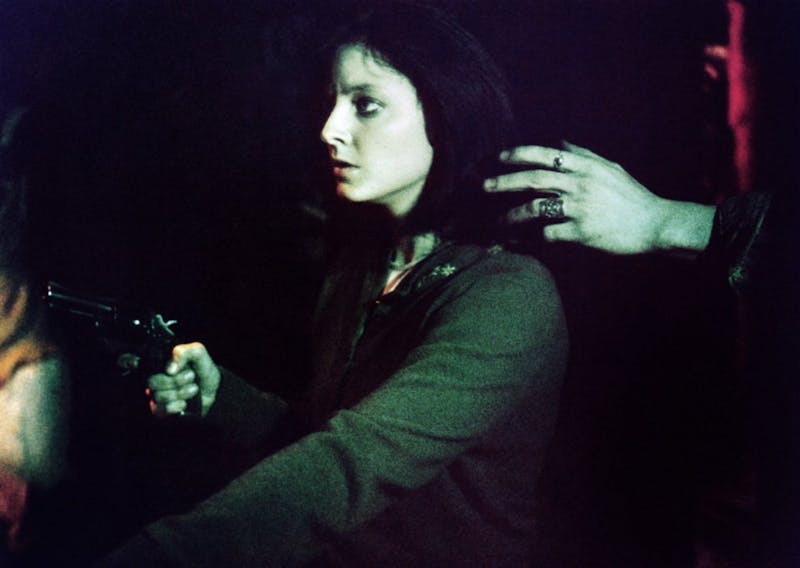Rookie FBI agent Jane Banner (Elizabeth Olsen) has just been pepper-sprayed. She gets it in the face while investigating a killing on the icebound Wind River Indian reservation in Wyoming. The murdered teenage girl has a brother, and he has been staying in a local drug den. He may well have been involved, his father says. When Banner goes to confront him, she is attacked and maced by another drug user. She gropes around through blurred vision and searing pain, but her weapon sits lightly and professionally in her hands. She kills a young Native American man who lives in this shell of a home.
The scene is a reference to a parallel one, coming at the end of The Silence of the Lambs. In that movie, Clarice Starling (Jodie Foster) stumbles in the pitch dark of Buffalo Bill’s home while he stalks her through night vision goggles. Her hands shake with fear and the gun wobbles. At the last second, she hears Bill cock his own gun in the dark, and she wheels around to fire, her hand suddenly sure.
In both movies, a female rookie FBI agent forms the emotional center of an investigation into wrongful death. Wind River has very different stakes to The Silence of the Lambs: It focuses on the systemic, unchecked violence committed against Native women, rather than the work of a couple of psychopaths. But, seen alongside each other, Clarice Starling and Jane Banner reveal American movie-making’s interest in the interiority of law enforcement personnel—especially pretty young white women. These movies watch their heroines suffer, fear, and bury it all under a calm surface of professional resolve, often in the face of horrendous violence and mortal danger. Their emotional interiority sits at a difficult and interesting place in our culture now, at a time when America is reassessing its relationship to the way that cops feel.

Women represent approximately 10 percent of law enforcement personnel in the United States. But in movies and television they are overrepresented. As well as The Silence of the Lambs, Wind River joins a genre that runs from The X-Files to Sicario to Miss Congeniality. In each of these movies, the young female agent is very beautiful. In each, she is self-assured and expert, but also brittle.
In Sicario, Kate Macer (Emily Blunt) loses her illusions about the nobility of her work fighting the war on drugs. At the movie’s end, the tough antihero Alejandro (Benicio Del Toro) tells her that she is “not a wolf.” She is left quivering by her experiences in Mexico, but this is what makes her an ideal protagonist. Because of her idealism and her resemblance to the pretty star of a simpler type of film—blink and you’ll mistake Sicario for a romance—Kate Macer holds the viewer’s hand like a nanny through a sophisticated, circuitous, and highly ambivalent movie.
Likewise, Clarice Starling is the true protagonist of The Silence of the Lambs. Her identity—her memories, her analytical powers, her gender—is almost the entire interest of the movie. Hannibal Lecter and Buffalo Bill are her foils. The viewer roots for Starling, banking on the hope that her mental prowess will trump her physical and emotional fragility to save the day (and the kidnapped girl). But what does it mean when a movie about crime revolves around the emotions of a single law enforcement professional?
In trial after trial after trial, America watches as police officers testify about their fear. As Benjamin Wallace-Wells wrote in the New Yorker last year, for police who shoot citizens “fear has been essential to their legal defense; it has also been, in a more basic way, their explanation.” It is vital that those police convince a judge or jury that their fear is authentic. At times, this ploy has seemed “cynical and absurd, because of the imbalance in power between the cops (armed, able to summon support, the arm of the law) and their victims.” Their testimony is also often rooted in “the basest racial fears, and to be expressed in the crudest language.” Darren Wilson “felt like a five-year-old holding onto Hulk Hogan” as he grabbed Mike Brown, a man significantly younger than himself, whom he would go on to shoot dead.
This is the type of emotion felt by law enforcement that has serious consequence to America as social and political environment. The fear felt by men before they kill is an emotion of national significance. But instead Hollywood gives us movie after movie about fear felt and then overcome by women. Why?
Cinema is accustomed to digesting the big themes that are needling society, but what movies produce in response to that stimuli is usually not its mirror image. Why do we like to watch movies about women terrorized by fear at all, one might ask. In The Silence of the Lambs, Clarice Starling’s fear is a bit like the fear felt by Ripley in Alien or Laurie Strode in Halloween. It’s related to Carol J. Clover’s Final Girl trope. In her 1992 book Men, Women and Chain Saws: Gender in the Modern Horror Film, Clover argued that the final surviving character in a good horror movie has to be female, because “abject terror” is only truly credible in a woman.
By the same token, the female FBI agent is rendered totally abject at moments in her movie. Starling has semen flung in her face by a jailed criminal; Kate Macer of Sicario has her face ground into the dirt by a man; Wind River’s Jane Banner is almost shot in the face by a rapist who marvels at how “spunky” the women “round here” are. Strange how it always happens to their face.
True abjection cannot be experienced by white male characters in cinema. Even when robbed of their weapons or jobs or status, white men are still in possession of a metanarrative of power—they’re not the right candidate for catharsis. This metanarrative is made up of a constellation of details. The movie’s structure probably does not require that the man experience sexual violence, as if often requires of its women protagonists. The movie itself has a 96 percent chance of being directed by a man. One reason why we never see men gripped by fear in our popular narratives is that men like to feel powerful, and most of the time, they’re the ones telling the stories.
At least, it’s one way of looking at things. A genre theory like this one is a little like a colored lens: it doesn’t change anything, but you can hold it up to things and see the balance of contrast change. Wind River is a deeply upsetting movie that contains a graphic rape scene and a great deal of maddening grief. It is beautifully shot. It is also a movie about the injustice done to Native Americans on a reservation that awards all the agency to two white protagonists—Elizabeth Olsen and her co-star, Jeremy Renner.
At a deep and icy level, Wind River is about power. That dynamic cuts in multiple directions, across race and gender and class. But genre awareness can give us more than the dynamics baked into a movie’s plot. Genre is a comparative idea—you have to see across movies in order to get a hold on a genre, which inevitably means that some details get flattened out. What movies do with our anxieties (why do cops kill?) changes from work to work, and from year to year. But if we are to learn anything new about our own hopes and fears for law enforcement, we have to find a new point of entry for movie-making: not cautionary pornography, or love letters to white feelings. There’s something else going on here, and white masculinity is at its heart. The movie that can wring catharsis out of that will be a long time coming.
